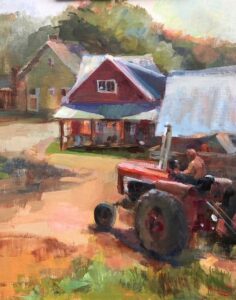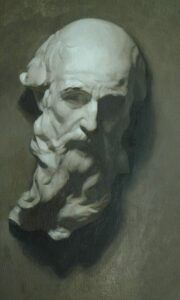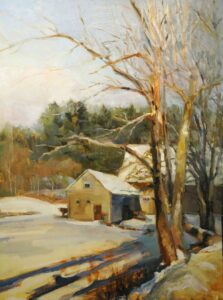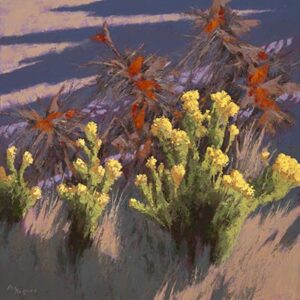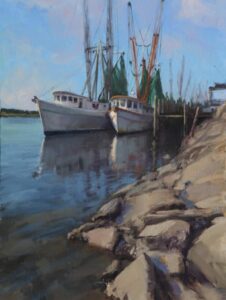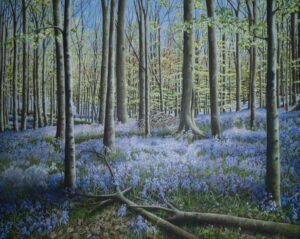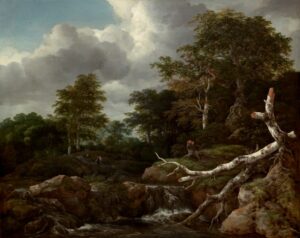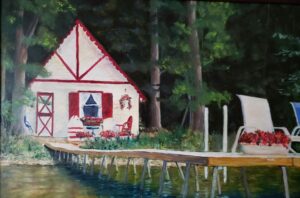Overcoming Plein Air Obstacles
I love plein air painting. Painting outdoors is such a special experience because of our unique engagement with the environment. Here we are with our panel, some colors, and our brushes, trying to convey something about the place where we stand – the light, the air, the wind, the bugs, the people – so much to take in. It can be an exhilarating experience, taking all of our concentration as we get lost in this world we are creating on the canvas.
But, as we all know, it’s not all sunshine and roses – even when we’re painting sunshine and roses. Like anything in life, the pursuit has ups and downs, and we must be flexible and learn to roll with things, both external and internal. This article is about getting over the hurdles that stand in our way. I have my obstacles; I am sure you have your own. Let’s find ways to work on overcoming some of the common ones.
Get out the Door
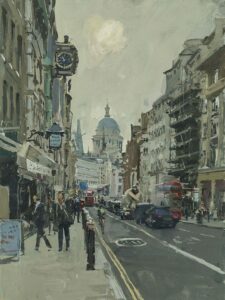
by Peter Brown
First things first, we have to leave the house. What is that thing that is going to get you out the door? For me, when I need an extra boost to find a couple hours to get outdoors, I fall back on my mantra, ‘What would Pete the Street do?’ For those not familiar, Peter Brown is a prolific British painter, best known for his paintings of his hometown of Bath. I don’t know him personally, but from what I can gather, he paints in the morning, afternoon, night and probably in bed. This may not be totally accurate, but for my purposes Pete the Street is the quintessential plein air painter. He isn’t going to let the weather, location, or pretty much anything stop him. He is going to make that painting! And be happy while he is doing it. So asking myself, ‘What would Pete the Street do?’ is my way of telling myself to pack my stuff, get out the door and get painting.
This works for me, and I know mantras may be a bit new-age-y for some, but finding your own short and simple way to remind yourself how much you want to get out there is a quick way to give yourself a boost when you need it. Maybe you post photos of paintings that inspire you on your refrigerator or play a piece of music associated with getting ready to go. The trick is to keep it simple, so there’s no debate – we’re out the door!
Set Your Easel Up. Yes, Right Here
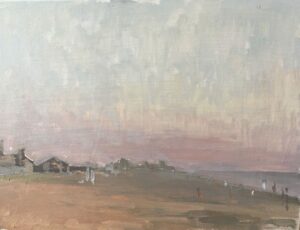
by Tim Clayton
Let’s find a spot to paint. Who hasn’t seen a beautiful spot they would love to paint and then thought, ‘But, there are so many people around.’ Yes, I know there are plenty of confident and social painters among us, but I would bet there are quite a few reading who would rather head for the safety of their studio than take the chance of lots of people looking at them while they work. I know this feeling very well. I love people, but insecurity in my work can definitely let those feelings creep in. But once again, our hero, Pete the Street comes in. ‘What would Pete the Street do?’ Yep, he just saw this beautiful building in town and he’s gonna set his easel up and paint it right there.
You would be amazed at how much confidence you can gain by taking the plunge and painting in public. While you may worry about our values or our drawing, most people are just going to be impressed that you are out there doing it! They aren’t coming to give you a critique. If anything, they will probably be impressed and give you a word of encouragement. And you will have gained valuable experience in painting this place or light effect that you have been wanting to paint. The next time will be so much easier, and so on, until you don’t give it a second thought.
Just a side note, I don’t want to minimize the value of privacy. Sometimes the ability to really focus and minimize distractions can be important. And, if you see a nice, private place to paint that might not be in the public domain, don’t be afraid to ask if you can paint on someone’s property. Owners of vineyards, marinas, farms, etc. may be excited to have an artist on their grounds, as it shows their customers and visitors that it is a beautiful place.
Stick With It
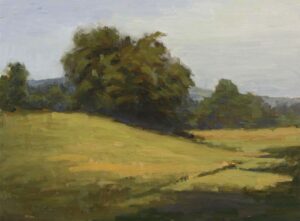
by Tim Clayton
All right, let’s do this! We’re out, we found a great spot to paint and…right, this is pretty hard. We all know that painting outdoors is not as easy as it may look. We get the rewards of beautiful days and fulfilling work. But challenging ourselves is part of the equation if we want to improve. Maybe you are comfortable with trees but stay away from a specific subject, such as architecture or water or people. Whatever it is, attempting those challenges will bring discomfort, either in the process or in the results. And that’s okay! To improve, you have to get comfortable with being uncomfortable; it just means you’re learning. And who knows, you may find that you have a real ability in your new subject matter. And more than likely, those reasons you were staying away will prove unfounded.
Embrace the discomfort and understand that if you want to progress to the next level, you will experience this feeling, sometimes in the middle of the painting and sometimes over a period of time. Stay with it though. Give your painting an extra 30 minutes past when you might stop, and try to figure out that thing that you know isn’t quite right. You may not resolve it on this painting, but sticking with it could provide the insight you need the next time you approach that problem.
Share Your Work
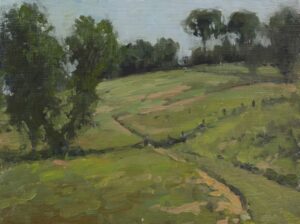
by Tim Clayton
After a solid effort out in the field, we made some progress, congratulations. And with that, we can do some evaluating. How does it stack up against your others? Better than the last? I admit, I often ask my kids for feedback – ‘Do you like this one?’
‘I like all your paintings, Daddy!’. Thanks, kids. Yes, they are 6 and 4 years of age, not the toughest critics.
But really, sharing your work can be a great way to increase the value of your time spent working. Instead of making a snap judgment – this is good or not good – taking the time to evaluate your painting with another person is a step toward real learning. Did you nail the composition, but missed on values? What was successful and what wasn’t? Finding friends, willing family members, or teachers to help you is invaluable.
And they don’t need to be painters or ‘art people’ to be helpful. When I have family visit, I purposely put out paintings where I want to see their reaction. It can be very helpful to see what people respond to, what emotional reactions they have. It helps me see my work through other people’s eyes. Sometimes it is so hard to see what is on the canvas without our emotional attachment. This makes sense. You put your heart into something; it can be pretty difficult to see it objectively. Let those around you help you with their observations; they probably see things you don’t.
Keep Going
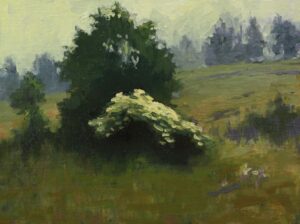
by Tim Clayton
Painting can teach us a lot about the world. We see things we wouldn’t otherwise see by observing the world in a way that few do. We connect with places and people by painting them and showing people how we see them. And we learn a lot about ourselves in the process. I hope some of the ideas in this article will help you look at your own obstacles and find ways to push through them so you can be free to pursue the paintings you want to make. Make sure to share them with us so we can give you a thumbs-up, and watch as you become a more complete painter.
